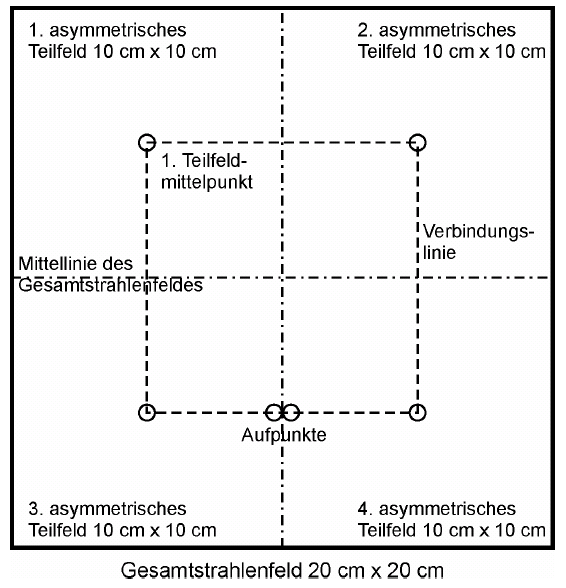
According to S5290 (Fig.1), the abuttment of four asymmetric 10x10 quadrants has to be checked at least twice a year (both energies).
 |
Fig.1:
Setup for split field test. Four fully asymmetric quadrants of 10x10 form
a 20x20 field. The resulting total dose distribution is checked for hot
spots or underdosages near the abuttals. (Image taken from ONORM S5290,
issue Nov 1, 2005). |
This test can easily be done with the 2D-ARRAY. In contrast to aS500 image acquisition, the measurement does not stop automatically when beam is off. This is a good feature, because jaws have to be moved three times until the full 20x20 area is irradiated. PortalVision would stop acquisition when jaws are moved to the next subfield and can therefore not be used here.
Low drift is necessary, since the full measurement takes 3 minutes or so (200MU for each quadrant at 300MU/min, plus time for jaw movement). Therefore, make sure that the ARRAY is warmed up.
A single 20x20 field can be measured as reference. Then VeriSoft 3.0 can be used to compare this to the 4 quadrants composite measurement. Fig.2 shows the sequence for one energy. Click all images to enlarge.
Performing the same test with radiographic film yields higher spatial resolution near the abuttals. BUT: what is the pass/fail criterion?
I think, for the same amount of jaw miscalibration ("jaw error"), a tool with high spatial resolution (=film) simply must allow higher tolerances for over- or underdosage (say, 20%) than a tool with lower spatial resolution (=ARRAY). Due to the integrating effect of the ARRAY chambers, I would tolerate no more than 10%. But when the criteria are fixed, both methods would trigger the same action (="recalibration of jaws") at the same time for the same amount of "jaw error". Only the action limits are different, depending on the method!
So the bottom line is this: film takes much more time for the same result.